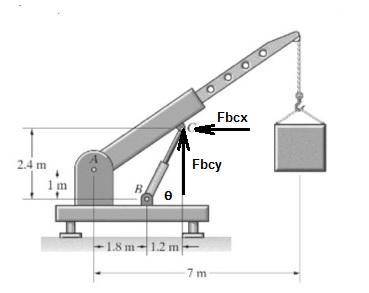
Q.1) The crane arm is pinned at point A and has a mass of 200 kg whose weight is acting at a point 2 m to the right of point A. The mass of the block is 800 kg. If the crane is in equilibrium, find (a) the magnitude of the force exerted on the arm by the hydraulic cylinder BC, (b) the support reactions at point A.

Answers: 1
Another question on Physics

Physics, 21.06.2019 22:00
Which type of microscope would allow the viewer to see ribosomes inside a cell?
Answers: 2

Physics, 22.06.2019 00:30
Imagine you work as a consultant, and your daily job involves listening to the constructive criticism of others. as part of your job, you must listen to opposing viewpoints to make important decisions. in this activity, you are a consulting dam engineer. you must make a decision about four different dams; should they be repaired, taken down, or left alone? you will listen to contrasting opinions about what should be done with the dams before you make the final decision. as the consulting dam engineer, what do you decide to do with this dam? explain your reasoning. by making your decision, did you support the opinions of the mayor and/or the dam safety official? why or why not? (site 1)
Answers: 1

Physics, 22.06.2019 14:10
What is the weight of a 8-kg substance in n, kn, kg·m/s2, kgf, lbm·ft/s2, and lbf?
Answers: 2

Physics, 22.06.2019 17:00
In the future, people will only enjoy one sport: electrodisc. in this sport, you gain points when you cause metallic discs hovering on a field to exchange charge. you are an electrodisc player playing the popular four disc variant. the disks have charges of qa = −8.0 µc, qb = −2.0 µc, qc = +5.0 µc, and qd = +12.0 µc. (1) you bring two disks together and then separate them. you measure the resulting charge of these two disks and find that it is +5.0 µc per disk. which two disks did you bring together? (a) a and b (b) a and c (c)a and d (d)b and c(e) b and d (f) c and d. (2) you bring three disks together and then separate them. you measure the resulting charge of these three disks and find that it is +3.0 µc per disk. which three disks did you bring together? a, b, and c (a) a, b, and d (c) a, c, and d (d) b, c, and d. (3) given the resulting charge of each disk measured in (b) is +3.0 µc, how many electrons would you need to add to a disk of this charge to electrically neutralize it? electrons
Answers: 3
You know the right answer?
Q.1) The crane arm is pinned at point A and has a mass of 200 kg whose weight is acting at a point 2...
Questions








Advanced Placement (AP), 06.05.2020 20:06




English, 06.05.2020 20:06



History, 06.05.2020 20:06


Mathematics, 06.05.2020 20:06

Mathematics, 06.05.2020 20:06





